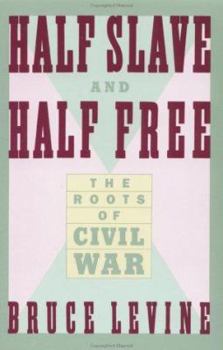Half Slave and Half Free: The Roots of Civil War
Select Format
Select Condition 
Book Overview
Revised EditionWith a New Preface and AfterwordIn a revised edition, brought completely up to date with a new preface and afterword and an expanded bibliography, Bruce Levine's succinct and persuasive... This description may be from another edition of this product.
Format:Paperback
Language:English
ISBN:0374523096
ISBN13:9780374523091
Release Date:April 1992
Publisher:Hill & Wang
Length:312 Pages
Weight:0.15 lbs.
Dimensions:0.8" x 5.9" x 8.2"
Customer Reviews
5 ratings
Graduate Student Review
Published by Thriftbooks.com User , 16 years ago
Bruce Levine's book, Half Slave and Half Free, is written about the divisions in America from the Revolutionary War to the Civil War. The slave based economy of the South and the free labor economy of the North and their differences that ultimately lead America to war. In the revised edition of Mr. Levine's book he has written a new preface and afterward and bibliography. He has added information based on new information made available since the book was initially published in 1992. Levine does not use footnotes, but does explain all of his references by chapter in a new bibliography essay. In the first five chapters Levine discusses the history of slavery and how the southern slave owners felt about their property. The evolution of crops grown in America, especially the South and how slaves were used to farm them is discussed at length. Levine also speaks of the population statistics of the South and says that only one quarter of the white population of the South are slave holders. The typical slave owner of the period, owned five or six slaves and land valued at approximately $3,000. (pp. 21) Also in the first five chapters Levine discusses the North and the social and economy setting there before the Civil War. He speaks on how the average household and farm is managed with the families providing most of the labor. Levine also explains the fact that many of the poorer white laborers in the North were put or put their selves in bondage as "Bondsmen" to pay their passage. Typically seven years of labor were required then they were set free and established farms or businesses for themselves. In chapter six Levine describes the beginning of the antislavery movement. The slaves stated that they had to lie to live. The resistance that the slaves used was very covert, deliberate clumsiness and stupidity, making the overseers explains the simplest task over and over. The women would even feign a pregnancy to get out of the fields for a while. The Planters stated they could never get the truth out of their slaves. (pp. 145) From the antislavery movement Levine speaks about the various issues of allowing slavery into the new states and territories. Southern leaders in Congress such as John C. Calhoun leading other Carolinians against the federal government. Tariffs on imported manufactures were the main issue. Calhoun stated that the South was left with only three choices: (1) assert the power in the reserved rights of the states - that is, "nullify the federal tariffs; (2) submit to have their domestick (sic) institutions exhausted; or (3) in the end be forced to rebel. (pp.162) South Carolina was the most sensitive to any issues against slavery for it had in its borders some of the largest plantations in the South. The first half of this book explains the point of view of both the South and the North about slavery. Mr. Levine drew upon many sources for his information and in this edition has updated much of his infor
Fabulous book
Published by Thriftbooks.com User , 16 years ago
This is a wonderful book that is great in the classroom. It is readable with terrific statistics to show the divergences between the North and the South before the Civil War. I have used it in class and my students got a lot out of it.
Thorough, insightful.
Published by Thriftbooks.com User , 18 years ago
Rarely, do I get excited about classroom readings however, Bruce Levine's Half Slave and Half Free is an insightful look at a pivtoal time in the history of the United States. Levine's argument in the text is that the deep regional divide which came to inspire the Civil War, was not founded on the principle of slavery but rather the contrast in the socioeconomic structures. An excellent look at the post revolutionary and pre Civil War United States.
The other side of the Civil War, The View of Blacks by South
Published by Thriftbooks.com User , 21 years ago
levine does a good job on this book.his research is pretty well. he documentsthat the civil war was just about an economic cycle, a cycle of money for thewhite southern man, the rich man to be precise.i like this book, because there is an inner worldthat usually never gets talked about, but levine proves that the cycle of racism and hatred by the white man toward the black female and male wereintense.literature is highly recommended.
An excellent book on the origins of the Civil War.
Published by Thriftbooks.com User , 24 years ago
An easy to read historical book dealing with the origins of the Civil War. Dr. Levine is succinct and thought-provoking in his analysis. Imploying political, economical, and social factors, Levine explores attitudes and conditions in both the North and South. Professor Levine's concentraion on social aspects and their effects on the "average" American is refreshing. I had the pleasure of studying and being instructed in this subject with Professor Levine while a student at the University of Cincinnati, while he still taught at that institution. This is an excellent book for this subject. I would also reccommend in this area: "Free Soil, Free Labor, Free Man," by Eric Foner; and "James Henry Hammond and the Old South, A Design for Mastery," by Drew Gilpin Faust.





